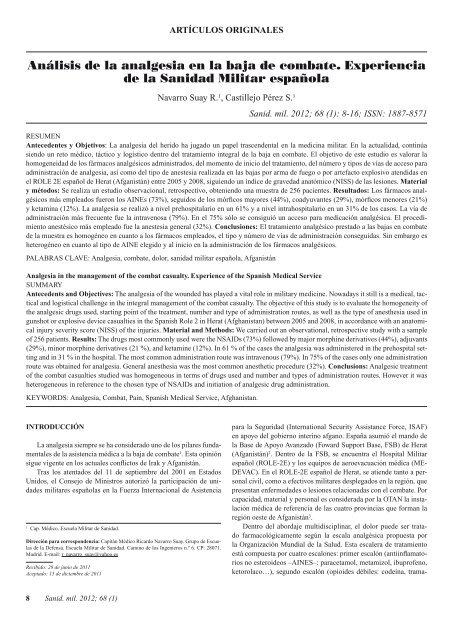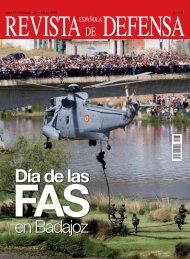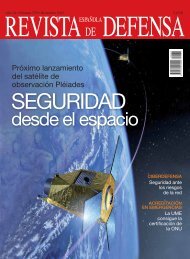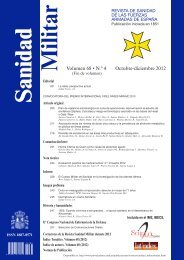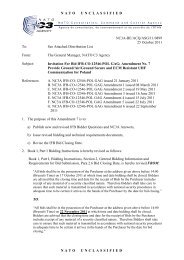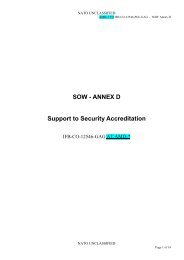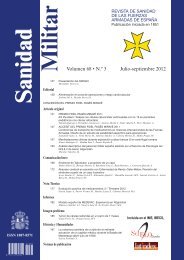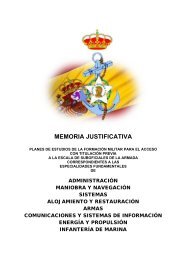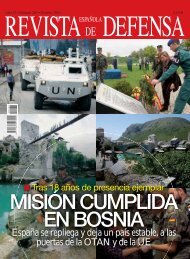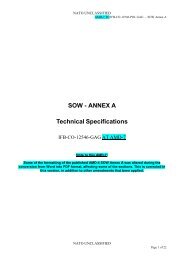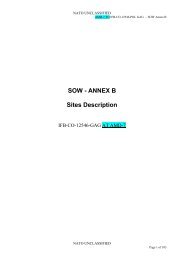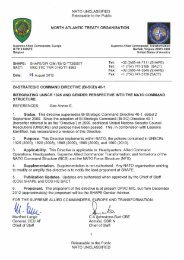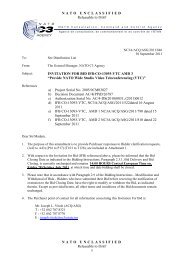Sanidad Militar - Ministerio de Defensa
Sanidad Militar - Ministerio de Defensa
Sanidad Militar - Ministerio de Defensa
You also want an ePaper? Increase the reach of your titles
YUMPU automatically turns print PDFs into web optimized ePapers that Google loves.
ARTÍCULOS ORIGINALES<br />
Análisis <strong>de</strong> la analgesia en la baja <strong>de</strong> combate. Experiencia<br />
<strong>de</strong> la <strong>Sanidad</strong> <strong>Militar</strong> española<br />
Navarro Suay R. 1 , Castillejo Pérez S. 1<br />
Sanid. mil. 2012; 68 (1): 8-16; ISSN: 1887-8571<br />
RESUMEN<br />
Antece<strong>de</strong>ntes y Objetivos: La analgesia <strong>de</strong>l herido ha jugado un papel trascen<strong>de</strong>ntal en la medicina militar. En la actualidad, continúa<br />
siendo un reto médico, táctico y logístico <strong>de</strong>ntro <strong>de</strong>l tratamiento integral <strong>de</strong> la baja en combate. El objetivo <strong>de</strong> este estudio es valorar la<br />
homogeneidad <strong>de</strong> los fármacos analgésicos administrados, <strong>de</strong>l momento <strong>de</strong> inicio <strong>de</strong>l tratamiento, <strong>de</strong>l número y tipos <strong>de</strong> vías <strong>de</strong> acceso para<br />
administración <strong>de</strong> analgesia, así como <strong>de</strong>l tipo <strong>de</strong> anestesia realizada en las bajas por arma <strong>de</strong> fuego o por artefacto explosivo atendidas en<br />
el ROLE 2E español <strong>de</strong> Herat (Afganistán) entre 2005 y 2008, siguiendo un índice <strong>de</strong> gravedad anatómico (NISS) <strong>de</strong> las lesiones. Material<br />
y métodos: Se realiza un estudio observacional, retrospectivo, obteniendo una muestra <strong>de</strong> 256 pacientes. Resultados: Los fármacos analgésicos<br />
más empleados fueron los AINEs (73%), seguidos <strong>de</strong> los mórficos mayores (44%), coadyuvantes (29%), mórficos menores (21%)<br />
y ketamina (12%). La analgesia se realizó a nivel prehospitalario en un 61% y a nivel intrahospitalario en un 31% <strong>de</strong> los casos. La vía <strong>de</strong><br />
administración más frecuente fue la intravenosa (79%). En el 75% sólo se consiguió un acceso para medicación analgésica. El procedimiento<br />
anestésico más empleado fue la anestesia general (32%). Conclusiones: El tratamiento analgésico prestado a las bajas en combate<br />
<strong>de</strong> la muestra es homogéneo en cuanto a los fármacos empleados, el tipo y número <strong>de</strong> vías <strong>de</strong> administración conseguidas. Sin embargo es<br />
heterogéneo en cuanto al tipo <strong>de</strong> AINE elegido y al inicio en la administración <strong>de</strong> los fármacos analgésicos.<br />
PALABRAS CLAVE: Analgesia, combate, dolor, sanidad militar española, Afganistán<br />
Analgesia in the management of the combat casualty. Experience of the Spanish Medical Service<br />
SUMMARY<br />
Antece<strong>de</strong>nts and Objectives: The analgesia of the woun<strong>de</strong>d has played a vital role in military medicine. Nowadays it still is a medical, tactical<br />
and logistical challenge in the integral management of the combat casualty. The objective of this study is to evaluate the homogeneity of<br />
the analgesic drugs used, starting point of the treatment, number and type of administration routes, as well as the type of anesthesia used in<br />
gunshot or explosive <strong>de</strong>vice casualties in the Spanish Role 2 in Herat (Afghanistan) between 2005 and 2008, in accordance with an anatomical<br />
injury severity score (NISS) of the injuries. Material and Methods: We carried out an observational, retrospective study with a sample<br />
of 256 patients. Results: The drugs most commonly used were the NSAIDs (73%) followed by major morphine <strong>de</strong>rivatives (44%), adjuvants<br />
(29%), minor morphine <strong>de</strong>rivatives (21 %), and ketamine (12%). In 61 % of the cases the analgesia was administered in the prehospital setting<br />
and in 31 % in the hospital. The most common administration route was intravenous (79%). In 75% of the cases only one administration<br />
route was obtained for analgesia. General anesthesia was the most common anesthetic procedure (32%). Conclusions: Analgesic treatment<br />
of the combat casualties studied was homogeneous in terms of drugs used and number and types of administration routes. However it was<br />
heterogeneous in reference to the chosen type of NSAIDs and initiation of analgesic drug administration.<br />
KEYWORDS: Analgesia, Combat, Pain, Spanish Medical Service, Afghanistan.<br />
INTRODUCCIÓN<br />
La analgesia siempre se ha consi<strong>de</strong>rado uno <strong>de</strong> los pilares fundamentales<br />
<strong>de</strong> la asistencia médica a la baja <strong>de</strong> combate 1 . Esta opinión<br />
sigue vigente en los actuales conflictos <strong>de</strong> Irak y Afganistán.<br />
Tras los atentados <strong>de</strong>l 11 <strong>de</strong> septiembre <strong>de</strong>l 2001 en Estados<br />
Unidos, el Consejo <strong>de</strong> Ministros autorizó la participación <strong>de</strong> unida<strong>de</strong>s<br />
militares españolas en la Fuerza Internacional <strong>de</strong> Asistencia<br />
1<br />
Cap. Médico. Escuela <strong>Militar</strong> <strong>de</strong> <strong>Sanidad</strong>.<br />
Dirección para correspon<strong>de</strong>ncia: Capitán Médico Ricardo Navarro Suay. Grupo <strong>de</strong> Escuelas<br />
<strong>de</strong> la <strong>Defensa</strong>. Escuela <strong>Militar</strong> <strong>de</strong> <strong>Sanidad</strong>. Camino <strong>de</strong> los Ingenieros n.º 6. CP: 28071.<br />
Madrid. E-mail: r_navarro_suay@yahoo.es<br />
Recibido: 28 <strong>de</strong> junio <strong>de</strong> 2011<br />
Aceptado: 15 <strong>de</strong> diciembre <strong>de</strong> 2011<br />
para la Seguridad (International Security Assistance Force, ISAF)<br />
en apoyo <strong>de</strong>l gobierno interino afgano. España asumió el mando <strong>de</strong><br />
la Base <strong>de</strong> Apoyo Avanzado (Foward Support Base, FSB) <strong>de</strong> Herat<br />
(Afganistán) 2 . Dentro <strong>de</strong> la FSB, se encuentra el Hospital <strong>Militar</strong><br />
español (ROLE-2E) y los equipos <strong>de</strong> aeroevacuación médica (ME-<br />
DEVAC). En el ROLE-2E español <strong>de</strong> Herat, se atien<strong>de</strong> tanto a personal<br />
civil, como a efectivos militares <strong>de</strong>splegados en la región, que<br />
presentan enfermeda<strong>de</strong>s o lesiones relacionadas con el combate. Por<br />
capacidad, material y personal es consi<strong>de</strong>rada por la OTAN la instalación<br />
médica <strong>de</strong> referencia <strong>de</strong> las cuatro provincias que forman la<br />
región oeste <strong>de</strong> Afganistán 3 .<br />
Dentro <strong>de</strong>l abordaje multidisciplinar, el dolor pue<strong>de</strong> ser tratado<br />
farmacológicamente según la escala analgésica propuesta por<br />
la Organización Mundial <strong>de</strong> la Salud. Esta escalera <strong>de</strong> tratamiento<br />
está compuesta por cuatro escalones: primer escalón (antiinflamatorios<br />
no esteroi<strong>de</strong>os –AINES–: paracetamol, metamizol, ibuprofeno,<br />
ketorolaco…), segundo escalón (opioi<strong>de</strong>s débiles: co<strong>de</strong>ína, trama-<br />
8 Sanid. mil. 2012; 68 (1)


